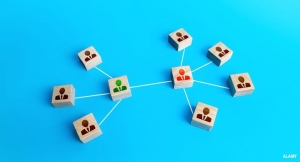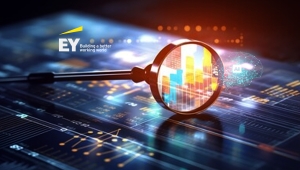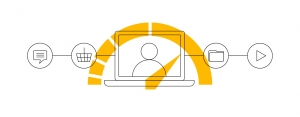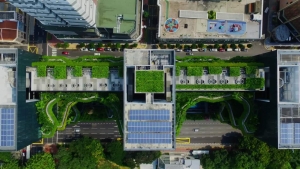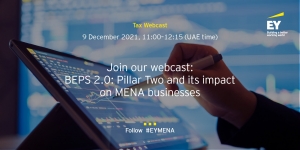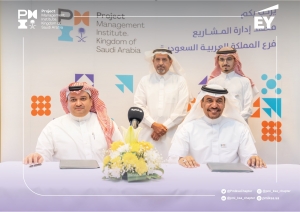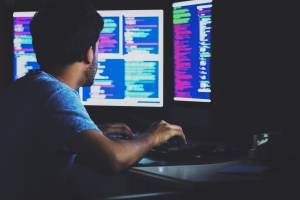عرض العناصر حسب علامة : EY
القيادة التي تحسن المرونة
وجدت دراسة استقصاء العمل المعاد تصوره لعام 2023 التي أجرتها شركة EY وجود تعارض بين الأولويات والضغوط والآفاق المستقبلية لأصحاب العمل والموظفين
تعلن EY عن إطلاق منصة الذكاء الاصطناعي EY.ai
أعلنت EY العالمية عن إطلاق EY.ai، وهي منصة موحدة تجمع بين القدرات البشرية والذكاء الاصطناعي (AI) لمساعدة العملاء على تحويل أعمالهم للذكاء الاصطناعي.
تطلق EY أكثر من 20 إمكانات تقنية Assurance جديدة مدعومة من تحالف Microsoft في السنة الأولى من برنامج الاستثمار
تعلن مؤسسة EY عن توسيع تعاونها مع Microsoft، حيث تكمل مؤسسة EY الأشهر الـ 12 الأولى من استثمار مدته أربع سنوات بقيمة تزيد عن مليار دولار أمريكي لتقديم منصة تكنولوجيا التأمين من الجيل التالي.
بسبب الغش في امتحان الأخلاقيات غرامة تاريخية على ارنست آند يونغ
فرضت السلطات الأميركية غرامة تاريخية على شركة المحاسبة "إرنست آند يونغ" بقيمة 100 مليون دولار بعد اكتشف المنظمون الحكوميون أن الشركة كانت تعرف أن بعض مدققي حساباتها كانوا "يغشون في امتحانات" الأخلاقيات لعدة سنوات ولم يفعلوا شيئا لوقف هذا التصرف.
كيف تعمل الثقة على تسريع التحول؟
معلومات إضافية
-
المحتوى بالإنجليزية
Trusted data and technology fuel new ways of working. Just ask Microsoft Xbox’s gaming ecosystem.
A version of this article was first published in MIT Technology Review in December 2020.
In brief
Trust is an essential ingredient for accelerated transformation and innovation.
Unless organizations anticipate and close the potential trust gaps, customers, markets and regulators will not embrace their new tech-driven innovations.
To close trust gaps, organizations must embed trust in data and technology from the outset, using an approach we call Trusted Intelligence.
Related article
Four ways organizations can prepare for a digital future
Four ways organizations can prepare for a digital future
If digital is fully integrated into a company's strategy, it can benefit all e…
10 Feb 2021 Richard Suhr
We are living in a time of increasingly intelligent technologies, when an organization’s ability to be trusted really matters. But the way data and intelligent technologies such as AI are being used is creating significant trust gaps. For example, the public feels that intelligent technology is moving too fast and that regulators can’t keep up, as documented in the 2020 Edelman Trust Barometer.
There are plenty of high-profile examples of data misuse and unintended outcomes from AI usage that have contributed to these gaps. One small example took place this June when an AI tool to reconstruct pixelated photos turned a photo of Barack Obama into a white man. It became a matter of hot debate in the AI community: was the bias towards creating more photos of white people than people of color the result of incomplete data or indicative of the racial bias baked into AI from non-diverse datasets and development teams?
Trust gaps have reframed the question of “Can tech do this?” into “Should tech do this?” It’s no longer about capabilities. It’s about trust in the intelligence that a business uses, and that customers, markets, regulators and ecosystems rely on. Can companies and government organizations ensure the outcomes of their technologies? Do they have reliable methods for identifying, tracing and correcting unintended outcomes? Without trust, the ability of an organization to operate and innovate is reduced and slowed down.
Trust in data and technologies results from action. There are methods and techniques that embed trust into data, trust into systems, trust into business models to create sustained value and empower transformation. At EY, we call this Trusted Intelligence.
Trust is not something you can bolt on. It has to be designed into data and intelligent technologies from the outset.
Marco Vernocchi
EY Global Chief Data Officer
How EY can help
Blockchain platforms
The future of doing business will be through tokens and smart contracts, enabled by blockchain. EY has a clear vision and strategy for how blockchain is digitalizing and integrating supply chains by knitting together business operations and finance at the ecosystem level.
Read more
“Trust is not something you can bolt on. It has to be designed in from the outset,” said Marco Vernocchi, EY Global Chief Data Officer. Trusted Intelligence embeds trust in a tangible way that embraces behaviors, processes, business models and outcomes as data moves through technology and the organization — accelerating transformation and the creation of long-term value.
Trusted Intelligence in action: the Xbox ecosystem
With thousands of developers, publishers, authors, designers, production houses and distributors, Microsoft’s Xbox gaming platform is a complex ecosystem of relationships. Collaboration across this ecosystem is key to producing a high-quality product that attracts the best talent and satisfies consumers – but Microsoft recognized there were points of friction that needed to be addressed.
A multitude of manual processes and siloed systems meant that developers and publishers couldn’t link complex calculations for royalties to the underlying data. As a result, they had to spend time and resources reconciling, validating and tracing back the transactions, then recalculating royalties to verify accuracy. Distributors found it difficult to reconcile data from different sources.
To cut through complexity and increase trust in the data, Microsoft and the EY organization partnered to co-develop the solution. The result was the first blockchain-based financial system of records for processing end-to-end royalty transactions, from contract creation through to integration with SAP for payments. The blockchain solution provides near real-time access to authentic trusted transactions data from source systems to game publishers, who can click and drill-down from transactions to source contract terms agreed with Microsoft.
The upshot? Publishers can access information on royalties earned in just 4 minutes instead of 45 days after month end. Royalties administration costs have been slashed. Increased trust in the royalties intelligence has given the ecosystem greater visibility of the underlying data. Microsoft benefits from faster, more efficient processes and lower operational costs.
With trust, everything moves more smoothly. Collaboration is easier. Innovation drives value. Technology can be deployed at speed.
How EY can help
Digital Transformation services
We help companies thrive in the transformative age by refreshing themselves constantly, experimenting with new ideas and scaling successes.
Read more
Embedding trust
Looking at the Xbox story, we can see that trust has been embedded into the intelligence of the business in a variety of ways:
Data from a multitude of manual workflows and unintegrated systems has been replaced with trusted data
Trusted data is also created by automating complex royalty calculations, product tokenization and onboarding smart contracts using AI based on secure cloud technologies
Trust is maintained through the blockchain-based system of record that generates invoices and statements with integration to SAP for settlement and processing of payments, as well as post-accounting journals
And finally, trust is embedded into how people work by applying clear rules and transparent processes
As businesses strive to carve out competitive advantage, applying Trusted Intelligence is creating a new frontier of opportunities to accelerate a distinctive digital transformation.
Accelerated transformation
While digital transformation was well underway prior to the pandemic, COVID-19 stepped up the pace. In a recent EY webcast on the impact of COVID-19 on customer experience with nearly 2000 participants, 82% said they were accelerating digital transformation.
This confirms what we’re experiencing with our clients in the market. We know that those achieving radical and exponential value creation are responding to three key drivers:
The ability to put humans at the center of what they do: When it comes to customers, value creators have shifted their orientation from “How do we get more customers to buy what we make or do?” to “How do we give customers more of what they want?” This change in mindset is backed by truly engaged employees who feel motivated and energized by their company’s purpose.
Deploying technology at speed: In other words, moving at the speed that today’s customers and employees expect and demand. This means automation through AI and other intelligent technologies, as well as cloud-based services. It means using agile methodologies and technology that helps you respond to dynamic conditions.
Innovating at scale: Organizations need to innovate on two levels – survival today and success tomorrow. It’s like a muscle that needs to be continuously flexed. Collaboration is the name of the game, for example through leveraging ecosystems of partnerships and alliances. To turn innovative ideas into value that is embraced by customers, citizens, markets and societies, it has to be built using large volumes of data, intelligent technologies and cloud infrastructure that are trusted.
Each of these drivers is amplified by Trusted Intelligence. Embedding trust into data is how data links to value, and how organizations can reduce trust gaps and accelerate their digital transformation.
كيف يمكن للتمويل المستدام أن يساعد في إزالة الكربون من الاقتصاد الحقيقي؟
لتمويل الانتقال إلى مستقبل مستدام، تحتاج المؤسسات المالية إلى تعميق معرفتها بالأعمال التجارية التي تمولها.
معلومات إضافية
-
المحتوى بالإنجليزية
To fund the transition to a sustainable future, financial institutions need to deepen their knowledge of the businesses they finance.
In brief
Banks, asset managers and insurers have set out their net-zero goals. To meet them, FIs need to fund ambitious transition pathways.
FIs that develop granular knowledge of sub-sector transition pathways will be able to structure financing in ways that incentivize tangible climate action.
To position themselves successfully as transition finance providers, FIs will need to invest in a workforce skilled at analyzing sub-sector pathways.
COP26 will be remembered as the moment when finance moved to the forefront of the fight against climate change. Political surprises — ranging from the "phasing down" of coal to closer cooperation between the US and China — may have grabbed attention. But for the business community, it was finance that generated the headlines.
The global financial services industry has a critical role to play in achieving net zero targets by midcentury. Estimates for the investments required to transition the energy sector alone by 2050 range from between US$3.5 trillion (pdf) and US$5.8 trillion per year. At COP26, former Bank of England Governor Mark Carney announced that 450 major banks, asset managers and institutional investors representing up to US$130 trillion in assets have joined the Glasgow Financial Alliance for Net Zero (GFANZ), with a commitment to align their lending and investment portfolios to Paris Agreement climate goals.
Financial institutions (FIs) recognize that the transition to net zero will involve more than simply investments and underwriting for “green” assets and businesses such as renewables and electric vehicles. In order to achieve net zero across the whole economy, browner, more carbon intensive assets and companies will require financing to help them transition to green. For many businesses, the transition will mean a fundamental change to their operations — and to make those changes happen, they will need capital. Insurers, lenders and investors will play a crucial role in making that capital available and in incentivizing and supporting their clients and investees as they make their transitions.
As the IPCC’s sixth assessment report made abundantly clear earlier this year, rapid action is needed if we are to mitigate against the worst effects of climate change. The report reiterated the need to limit warming to below 1.5˚C and warned that despite these pledges, the IEA claimed that collectively they would only limit average temperature increases to 2.1˚C by the end of the century, which is not even in alignment with the lesser ambition of the Paris Agreement. The IEA’s estimates are optimistic. According to the UN’s latest annual Emissions Gap report, also published in October, climate commitments and plans from national governments are currently aligned with a 2.7˚C temperature increase.
New pledges made in Glasgow, if delivered, could take the world on a trajectory to 1.8˚C of warming at best. However, as stressed by the International Energy Agency (IEA) who analyzed the targets, implementing them will be key and is by no means a given. At a macro level, domestic implementation will mean increased disclosure and transparency requirements, greater scrutiny of targets and transition plans, and consolidation of sustainability reporting frameworks.
How EY can help
Sustainability and supply chain advisory
Our teams can help you understand risks to supply chains such as human rights issues, resource constraints, climate change and government payments.
Read more
Risks and returns
The material risks of climate change — sea level rise, biodiversity loss, drought, wildfires, floods and loss of life — are themselves a compelling reason to act on the transition. To act on climate change is to act in the interests of people and the planet. But as well as their duties to society, FIs are ultimately structured around financial returns. They have a fiduciary duty to identify and protect their shareholders from foreseeable risks that might affect those returns. Failing to act on climate change would increase those risks substantially — and could reduce global annual economic output by $23 trillion by mid-century, according to research by SwissRe. As Emma Herd, EY Oceania Partner for Climate Change and Sustainability Services explains, “the core obligation [of financial services] is to respond to market information and to manage risk and to lean into economic trends, and climate change and sustainability is the biggest economic trend of this century.”
But the transition to net zero will not merely be about risk mitigation, it will also represent a tremendous opportunity for FIs. John Kerry, the U.S. Special Presidential Envoy for Climate, has called the energy transition “a vast commercial opportunity as well as a planetary imperative.” Furthermore, the transition to a low-carbon economy is projected to aid economic growth. A joint analysis by the International Energy Agency and the International Monetary Fund estimates investments in the clean energy transition will add an extra 0.4% to global GDP each year. Under a net-zero pathway, global GDP would be 4% higher by 2030 as compared to other models.
FIs acting early on the transition will be able to take advantage of this global economic opportunity first and they will be paving the way to a more profitable future. But to really grasp this transition opportunity with both hands, EY believes that FIs need to focus on a series of practical steps across the lifecycle of an investment, loan or underwriting process that will enable FIs to better evaluate transition plans at a sector and sub-sector level.
البث الشبكي: الركيزة الثانية في مشروع BEPS 2.0 وتأثيرها المحتمل على الأعمال التجارية في منطقة الشرق الأوسط وشمال إفريقيا
معلومات إضافية
- نوع الفعالية مجانا
- بداية الفعالية الخميس, 09 ديسمبر 2021
- نهاية الفعالية الخميس, 09 ديسمبر 2021
- التخصص أخرى
- مكان الفعالية أونلاين
توقيع مذكرة التفاهم بين ارنست اند يونج ومعهد إدارة المشاريع فرع المملكة العربية السعودية
وقعت EY و PmiksaChapter مذكرة تفاهم لدعم نمو مهنة إدارة المشاريع للسعوديين (PM) وتطوير العاملين في هذه المهنة في المملكة العربية السعودية
معلومات إضافية
-
المحتوى بالإنجليزية
EY signs MoU with PMI-KSA to support growth of Saudi Arabia’s project management profession
Press contact
Lamice Murshid
EY MENA Brand, Marketing and Communications Leader
email LinkedIn
Related topics
Consulting
EY has signed a Memorandum of Understanding (MoU) with the Project Management Institute (PMI) chapter in the Kingdom of Saudi Arabia (KSA) to support the project management profession in KSA.
The MoU with PMI-KSA is in line with the growth of the project management consulting services offered by EY. It will allow for improving project management competencies based on EY’s practical experience on the ground while capitalizing on the knowledge, standards, and methodologies of PMI. Also, EY will be able to benefit from the PMI wide network to share its leading practices and solutions locally and internationally.
The collaboration is part of EY’s greater commitment to supporting clients through their transformation execution journey. Ensuring their employees are trained on the latest solutions and able to utilize leading practices add a differentiating value for clients while also streamlining their processes to accommodate the rapidly changing business environment and technology landscape.
In addition, the memorandum will create further opportunities for Saudi nationals to become experts in the project management profession, supporting the nationalization agenda of the country.
Tariq Abu Obaid, General Manager of EY’s Consulting Firm in KSA, says:
“EY is proud to work with PMI-KSA in an effort to train our employees and ensure they always have the latest procedures, tools, and technology to best serve the needs of our clients. At EY, we believe that in order to continue to build a better working world, we must empower our people with the right mindsets and capabilities to navigate what’s next and become the transformative leaders the world needs.”
“This memorandum to train our project management consultants also reaffirms our commitment to contributing to the local business landscape. With Saudization reaching more than 60% in our KSA offices, we want to ensure that we are giving the decision makers of tomorrow a well-rounded and hands-on experience so they can better serve our nation in the future.”
Badr M. Burshaid, President of the Project Management Institute, Saudi Arabia Chapter, says:
“The MoU between PMI-KSA and EY will help grow not only the number of project management professionals in Saudi Arabia, but deepen the skillset and proficiency of the talent that is currently working here. The PMI-KSA Chapter facilitates the training and development of project management strategies and techniques for project execution across all businesses and government sectors in Saudi Arabia. Currently we have over 1,800 members and have held nearly 40 webinars to support professionals. In addition, Saudi Arabia is ranked as the number #1 place where certificates in RMP, PfMP, SP, and PBA are obtained.
Today PMI-KSA is one of the largest project management institutions in the Middle East, and we w - البلد الأردن
كيف يمكن للحكومات حماية المدن الذكية من تهديدات الأمن السيبراني؟
مع تحرك المدن الذكية نحو الرقمنة السريعة، مع التركيز على التقنيات التخريبية لتطوير بنية تحتية متقدمة لتكنولوجيا المعلومات والنظام، فإن المخاطر المحتملة للهجمات الإلكترونية يزيد معها.
معلومات إضافية
-
المحتوى بالإنجليزية
How can governments safeguard smart cities against cybersecurity threats?
By Samer Omar
EY MENA GPS Consulting Cyber Competency Leader
7 minute read
3 Oct 2021
Related topics
Government and Public Sector Innovation Cybersecurity
Upvote 20
Show resources
EY WGS security by design 2021
Download 2 MB
EY WGS security by design 2021 Arabic
Download 2 MB
As smart cities move toward rapid digitalization, focusing on disruptive technologies to develop an advanced IT and system infrastructure, the potential risk of cyber attacks
increases with it.
In brief
Cities with Inhabitants over 10 million people will increase from 33 in 2018 to a projected 43 in 2030 with a rise to 2.1 billion residents over the age of 60 by 2050.
Smart cities are extensively utilizing new technologies such as artificial intelligence (AI), biotechnology, machine learning, big data, quantum computing and 5G to offer smart services to residents, which in turn has substantially improved their lifestyle and well-being.
The rush to implement disruptive technologies and innovate systems and operations opens smart cities to multiple attack surfaces and vulnerabilities across the city ecosystem; exposing themselves to a growing number of security risks.
In such a scenario, a Security by Design approach is essential to safeguard smart cities and prevent cyber attacks. Security by Design is a new approach to cybersecurity that builds in risk thinking from the onset, enabling global innovation with confidence.
As the number of city residents continues to increase, the demand for rapid expansion and digitalization of urban areas into smart cities has further increased. By 2050, approximately 70% of the world’s population is expected to live in cities. This expansion requires technological and sustainable improvements to balance the social, economic and environmental impacts of these migrations.
The EY Security by Design report covers the challenges, risks and potential solutions for governments to safeguard smart cities from threats and attacks. Although different challenges require differing approaches to the implementation of a digitally enabled ecosystem, the three core considerations during transformation are population risk awareness, effective processes and adoption of disruptive technologies.
The report covers five main topics essential for cybersecurity in smart cities and identifies trends for governments to prepare for including infrastructural improvements, digitalization, population increases, complimentary regulations and agile response teams, and operating models. The five topics are discussed in detail in the EY Security by Design report (pdf):
Disruptive technologies
Security challenges and solutions
Cybersecurity trends
Cyber threat landscape
Government considerations
These components help governments to stay ahead of cybercrime and that they are able to innovate, prioritize and understand the risk landscape and opportunities for security control. These critical areas also ensure that smart cities are initially designed and built with a Security by Design concept in mind.
1
Chapter 1
Disruptive technologies at work
Developing intelligent infrastructure through gathered insights
Governments have harnessed disruptive technologies to improve decision making and enhance efficiency while reducing challenges. The primary benefits include the development of intelligent infrastructure through gathered insights. There are three primary technologies impacting smart cities:
Internet of things (IoT) and sensors: These sensor based technologies gather data which is analyzed for transformative digital implementations. The increased cloud computing usage has led to an increased number of entry points for cyber attackers. Governments must consider data protection politics, defense approaches and security solutions to mitigate risk.
Connected cars: Automotive suppliers face challenges with respect to protections for connected and autonomous vehicles due to lack of regulations. A Security by Design approach would require standardizations and minimum security requirements for manufacturers to implement.
Smart meter and smart grid: These predictive technologies collect large amounts of data through partnerships and need to be protected. Detective, preventative and reformative measures need to be integrated alongside government regulatory frameworks, policies and procedures to help to digitally transform the power infrastructures.
2
Chapter 2
Security challenges and solutions
Exploring innovative strategies to make up for outdated technologies
To ensure sustainable development of smart cities and overcome the challenges of antiquated infrastructure during the rapid urbanization, cities must rethink their innovative strategies to counterbalance outdated technologies.
Estimated cities
00
Will have between 5 and 10 million inhabitants by 2030.
Eight core security challenges have been identified for the consideration of cities across Africa and the Middle Eastern regions:
Insecure hardware: a lack of testing and standardization has let to vulnerabilities to cyber attacks and signal failures.
Linking vision with strategy and policy: a misalignment between strategies, policies and regulations and the vision for smart cities.
Multiple implementation programs: numerous initiatives running in parallel leads to the prioritization of solving logistical challenges and a lack of attention on security vulnerabilities.
Larger attack surface: an increased number of potential entry points for hackers due to the large number of individual devices connected to the network.
Inadequate funding and finance: cities often compensate for reduced budgets by decreasing cybersecurity budgets in favor of large-scale technology investments.
Lack of standardized security architecture: a lack of standardization and communication between city systems and security controls.
Operational Technology (OT) infrastructure security controls: an OT infrastructure that is administered by a generic IT infrastructure.
Deployment of disruptive technologies: a lack of practicality and cost-benefit analysis in adopting disruptive technologies.
Governments need to take an active role in the urbanization and transformation of cities and embed a Security by Design approach into their smart city transformation and technology implementations to reduce the risk of cyber attacks.
They must also establish responsible committees, security initiatives and a multifaceted defense-in-depth approach to protect connected devices while taking note of the potential challenges. In order to develop sustainably, governments must also factor in costs and security architecture design to account for rapid urbanization.
3
Chapter 3
Cybersecurity trends
Knowing the trends to stay one step ahead
EY researchers identified thirteen trends that may pose a challenge to the infrastructure of a smart city:
IT infrastructure improvement
Rise of megacities
Demographic shift
Technology implementations
IoT
Carbon removal solutions
Cybersecurity expertise
Harmonization
Crown jewel identification
Cybersecurity program refresh
Computer emergency response
Laws and regulations
Agile operating model
The most staggering trend is the discrepancy between cybersecurity implementation and smart city digital adoption. According to the IMD Smart City Index Report 2020, security is not considered a priority for top-ranking smart cities, an initiative that should otherwise be inseparable from smart city developments.
4
Chapter 4
Cyber threat landscape
Understanding the entirety of potential and identified cyberthreats
Almost half of corporate boards believe that cyber attacks will harm their business over the next 12 months. In order for smart cities to develop their cybersecurity, they must first understand the threat and risk landscape.
WGS graphic 01
Governments and authorities must consider the types of threats and potential impacts of the attacks and proactively assess and account for cybersecurity safeguards. The EY report identifies three categories of cyber attacks on governments.
WGS graphic 02
5
Chapter 5
Key considerations for governments
Toward safer and sustainable new infrastructures
As new technologies are adopted and smart cities utilize more interconnected systems with single data consolidations, new procedures and regulations are required to ensure the safety and sustainability of new infrastructures.
Governments must account for seven key considerations to maintain a resilient smart city:
Interaction and collaboration: the relationship between cybersecurity and other teams and lines of business
Big data and predictive analytics: considering big data management and the application of security controls to information databases and repositories
Testing environment: mandating the usage of testbeds across all critical infrastructures and new technology systems
Security Architecture: creating standards for architecture based on infrastructure networks, data collection, IT platforms, city structure and service offers
Zero trust and micro segmentation: security procedures to authenticate users and segmentations between cities to mitigate threats
Physical security: Implementation of security cameras in conjunction with AI technology
Public-private partnerships: Government support by the private sector to mitigate the challenges of rapid urbanization
Summary
Today, it has become imperative that governments across the world analyze the importance of having an impenetrable cybersecurity system in place, and disseminate cyber awareness to the masses, to thwart any possible attacks. Staying one step ahead of cybercriminals is the need of the hour, as the world stands battered by the COVID-19 pandemic and is forced to rely on the virtual connectivity across all fields and sectors. The governments need to prioritize assets, understand the risk landscape and implement enhanced levels of security control to better manage and mitigate the forthcoming risks. - البلد الأردن
هل أنت مستعد لإعادة صياغة العمليات لتحقيق المرونة والاستدامة؟
يقوم مديرو العمليات الذين يتعاملون مع تعقيدات عالم متغير ومتقلب بإعادة بناء عملياتهم من الألف إلى الياء لتزدهر في المستقبل.
معلومات إضافية
-
المحتوى بالإنجليزية
COOs navigating the complexities of a changed and volatile world are rebuilding their operations from the ground up to thrive in the future.
Three questions to ask
How are you turning your supply chain into an agile supply network?
Are you ready for the data and technology risks that come with connected operations?
How does the workforce fit into your plans for resilient and sustainable operations?
Until recently chief operating officers (COOs) have focused primarily on fine-tuning the value chain for speed to market, efficiency and profitability. But the world has changed — at first gradually and now suddenly. Over the last several years, empowered consumers, employees and investors, climate change, geopolitics and technology innovations have disrupted organizations, pushing them to change how they operate. Over the last 18 months, the COVID-19 pandemic turned that slow push into a giant, forceful shove. And COOs have had to figure out on the fly how to operate in this changed environment.
Organizations may still be making the same products and services, but everything about how these products and services are designed, manufactured and delivered to customers is different. This shift is forcing COOs to reimagine their supply chains for agility and sustainability as much as optimization. Across the enterprise, technology innovations are helping COOs transform how the business operates to meet multiple, simultaneous demands from a range of stakeholders — and increasing the chances of cyber infection. Reskilling and upskilling the workforce can help accelerate digital transformations and address cyber risks. And all this in the global context of economic and techno-nationalism.
To navigate this increasingly complex and volatile world, COOs need to reframe their future for operational resilience and sustainability.
Low angle view of lighthouse by rocky mountain against sky1
Chapter 1
Resiliency begins with visibility
Leading COOs are making the leap from linear supply chains to agile networked ecosystems.
How EY can help
Supply Chain Transformation
Consulting at EY can turn your supply chain transformation ambitions into reality through the power of people, technology and innovation. Find out more.
Read more
Operational resilience begins with the value chain. As a leading COO, you need to transform your organization’s rigid, linear value chain into an agile, networked ecosystem. There are three areas to prioritize for measurable results.
1. Create real-time, end-to-end visibility
Today’s technology allows you to cost-effectively build a virtual model of your physical end-to-end supply chain. Known as a digital twin, this virtual model gathers and connects data from various sources and systems across the supply chain network to create a virtual replica, containing the same supply entities, parameters and financial targets. Leveraging digital twins paired with simulation capability, you can then use control towers to make data-driven decisions using real-time data, improving agility in both sensing and responding to disruptions. With the accelerated speed of disruption today, simulations need to be repeated and acted upon continuously to manage the risks.
2. Develop resilient and sustainable sourcing
Resilient and sustainable decision-making relies on constantly finding the right sourcing balance. Diversity of sources can help maintain competitiveness. However, over-diversification can limit your ability to develop trusted relationships with suppliers. At the same time, vendor and geographic concentration could leave you vulnerable to disruptions such as vendor insolvency or civil unrest. Today’s volatile and ESG-focused environment demands prioritizing trusted partnerships and ecosystems to mitigate risk, improve operational assurance, and support sustainable strategies.
To know who to trust and where the risks are, you need a sourcing strategy that maps and tracks suppliers, facilities and products down to raw materials. This approach will help to improve operational transparency and traceability, and allow analysis of supplier compliance, KPIs and supply chain risks.
3. Build omni-capable networks
Delivering products and services when, where and how customers expect them requires agility and the right capabilities. This may mean fulfilling a customer’s need faster and cost-effectively from a store rather than a distribution center if it’s closer and has the inventory. Building the right distributed order management (DOM) capabilities coupled with digital control towers for Tier N visibility can help maximize the value of inventory through accuracy and visibility, positioning it where it’s most needed.
Windmills on field against sky2
Chapter 2
Net-zero operations provide net positive business benefits
Leading COOs see stakeholder demands for improved ESG performance as more than a compliance exercise.
Related article
Why net-zero supply chains are the next big opportunity for business
Why net-zero supply chains are the next big opportunity…
Focusing on sustainability encourages you to rethink your business for the f…
2 Aug 2021 Velislava Ivanova
Value chains also hold the key to sustainable operations. Many organizations have committed to or have ambitions to decarbonize their operations through net-zero targets. Leading COOs have three ways to turn what is often seen as a compliance exercise into a new source of competitive advantage and an important driver of transformation.
1. Decarbonize the value chain
Efforts to decarbonize the value chain begin by assessing your organization’s carbon footprint — as well as the carbon footprint of every partner and supplier in your ecosystem. In doing so, you can identify ways to reduce greenhouse gas emissions, set emissions reduction goals, prepare reporting and improve rating scores against global guidelines. Real-time visibility, quantification and traceability of data throughout your extended operations are prerequisites for this kind of assessment and action — as is a clear business case to support it. However, the benefits of improving ESG performance across the entire value chain are clear: enhanced processes, lower costs, increased productivity, innovation, differentiation and improved societal outcomes.
2. Build circular product lifecycles
In addition to your decarbonization efforts, as the COO, you’ll want to take the lead in working with other business units to design products for a second life, or that can be recycled or repurposed. To engage in the circular economy, you’ll need to implement circular operating models with closed material loops. As always, gathering data along the value chain and conducting analyses are critical to identify circular market opportunities.
3. Embrace tax planning
Tax penalties and incentives are playing a key role in driving sustainability initiatives globally. Work closely with the tax leader to align the organization’s tax profile with your operational footprint. You may decide, for example, based on tax implications, to relocate heavy-emitting operations to jurisdictions where tax penalties are lower or incentives are higher. However, in doing so, you will need to balance the benefit of relocating with potential downside implications, such as transfer pricing adjustments that may not be favorable, or the reputational risk of moving emissions rather than reducing them. By teaming with tax, you can help to reduce the impact of carbon taxes, while taking full advantage of sustainability incentives — with a particular focus on circular supply chains.
Low angle view of industry against clear sky3
Chapter 3
Tech and data ecosystems balance rewards and risks
Opening operations to better, faster decision-making also increases third-party risks and cyber attacks.
A suite of new technology tools — intelligent automation, data and analytics, internet of things (IoT), cloud — are helping COOs gather real-time data, sense and measure current reality, and predict and act in near real time. Used to maximum effect, these tools can help you build agile supply networks and elevate business performance across the enterprise.
Many COOs undertaking digital transformations to incorporate these new tools continue to make decisions using statistics, intuition and experience. As a COO, you need to be making decisions that are predictive and data-driven. But with this expanded potential comes increased risk. Data-driven decisions require petabytes of data. As a result, you may be integrating third-party technologies and acquiring third-party data to better anticipate customer needs, build networked supply chains that can manufacture personalized products, and innovate a new generation of logistics that can deliver products faster and more cost-effectively.
In the quest to gather as much first-party data as possible, you may also be more willing to open operations, networks and systems to wide-ranging connectivity, including areas that have never before been connected to the internet. The more connections an organization has — to systems, networks, suppliers, partners and ecosystems — the greater the risk of infection and attacks such as ransomware.
According to the EY Global Information Security Survey 2021, many organizations are still accustomed to a reactive cybersecurity mindset. As a COO, you must adopt a mindset of security by design. Security by design requires integrity analyses when the technology is acquired and then testing of the technology as it’s introduced into the organization. Cybersecurity is also easier to manage in a cloud environment than in a legacy environment. But the integrity of data in the cloud is only as good as the integrity of the third parties that supply it. Developing trust among third-party suppliers requires a change in governance and management operations.
You’ll also need to rethink the definition of workforce. It’s harder today to distinguish between a third-party provider, customer, employee and contractor. In this context, the workforce acts as a mechanism for propagating malicious code and a vulnerable point of attack by threat actors.
Pigeons flying in city4
Chapter 4
Resilient operations require a resilient workforce
Employees need to feel good about where they work and confident in their contribution.
Today’s supply chain and operations workforce needs to analyze data, identify outcomes and offer recommendations. This requires a digital fluency and familiarity with information and processes that may not come naturally to traditionally trained workers. In a recent EY survey, Reinventing the supply chain for an autonomous future, only 44% of respondents said their employees were prepared for digital innovation in the supply chain.
As a COO, knowing your people are at the center of any successful rebound strategy, you’ll want to work with the chief human resources officer (CHRO) to mix recruiting with upskilling, retooling and continuous improvement. Additionally, consider a redesign of your workforce to access capabilities across people, process, technology, analytics and metrics. This may include working with both the CHRO and the chief information security officer (CISO) to upskill employees to become “citizen developers.” This approach will have the advantage of gaining a combined skillset that blends IT skills with knowledge of the business. By working directly with the CISO and the cybersecurity team to nurture “citizen developers,” you also improve your function’s ability to better manage the rising torrent of cyber risks.
In addition to assisting in skills development, you’ll want to motivate your people by creating a purpose-led vision of the future. This includes a clear development path with performance incentives. You’ll want to work with the CHRO to design individual programs that support the health and well-being of each of your employees. These efforts provide employees with more confidence in what they do and more satisfaction about where they work.

